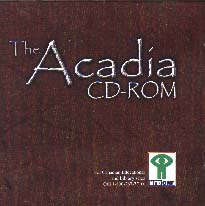| ________________ CM . . .
. Volume VIII Number 5 . . . . October 5, 2001
One of CD-ROM technology's
great advantages is its ability to combine text, still or moving images
and sound, presenting material with richness and depth. The Acadia
CD-ROM, an NFB co-production, offers print, pictures, and sound, presented
in some truly creative ways: "pages" of a virtual book turn with the click
of a mouse, books pop up out of an interactive bookshelf, audio clips
provide musical accompaniment, and rolling a computer mouse over arrows
on a map displays the destinations and fates of the dispersed Acadians.
The graphic presentation is also similarly inventive: the opening credits
feature video sequences enacting the dispersal of the Acadians, faux wooden
borders frame many of the screens, and the typeface of many of the text
headings provides authenticity, without sacrificing readability. Well-designed
though it is, navigation within the main sections of the CD is not intuitive
- read the information in the "Help" section for efficient use. Printing
any page of information is very easy, although users should realize that
the hard copy will be black and white text and not the full-colour of
the screen version (probably a good thing for owners of colour printers).
The Acadia CD-ROM is a comprehensive
overview of Acadian heritage, past and present. The content is divided
into four main sections: "History of Acadia" details the dispersal of
Acadians in 'Le Grand Derangement"; "Voyage to Acadia" offers virtual
tours of and textual information about the many Acadian heritage museums
and historical sites in New Brunswick, Nova Scotia, and P.E.I.; and
"Culture and Traditions" contains a range of materials ranging from
genealogy, folklore, and a focus section on Acadian women to haunting
audio-clips of traditional and current Acadian song, an audio-visual
dictionary of Acadian words and expressions, and, of course, the full
text of Longfellow's poem, "Evangeline." The last section, "Acadia of
the Maritimes," is a collection of essays, produced at the Centre for
Acadian Studies in Moncton. Some of the essays have a fairly specialized
focus, but none is inaccessible to high school students.
The story of the Acadians is, at times, a sad
one, but it is also a story of a culture that has survived with spirit
and vitality. In many Canadian history classrooms, the dispersal of
the Acadians is a brief lesson, and students rarely have any sense of
the difficulties faced by these unwilling emigres. Nor do students have
an understanding of the uniqueness of Acadian culture and of its continuing
pride in its heritage. There is a wealth of material in this CD, and
it is certainly worth acquiring as a supplemental resource for Canadian
history courses in senior high schools and as an information resource
for high school libraries, particularly those which have strong local
interest in the topic.
Highly Recommended.
Joanne Peters is a teacher-librarian at Kelvin High School in Winnipeg,
MB.
To comment on this
title or this review, send mail to cm@umanitoba.ca.
Copyright © the Manitoba Library Association. Reproduction for personal
use is permitted only if this copyright notice is maintained. Any other
reproduction is prohibited without permission.
Published by
NEXT REVIEW |TABLE OF CONTENTS FOR THIS ISSUE - November 2, 2001.
AUTHORS | TITLES | MEDIA REVIEWS | PROFILES | BACK ISSUES | SEARCH | CMARCHIVE | HOME
|
